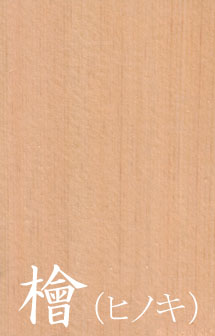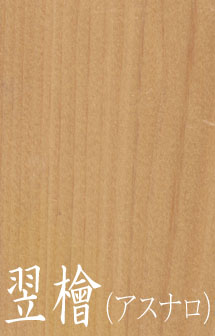type of wood

durability and sublime fragrance
hinoki: white/pinkish, with a delicate lemon scented aroma. More expensive and lightweight. Japanese are crazy for hinoki because of its “pure” image. Hinoki is the “prince of japanese wood.”
Hinoki means literally “tree of fire” as it was used antically to spark a fire, thanks to its dry nature. Hinoki is the material used to build castles and shrines, to carve sculptures or noh masks, it has almost a sacred status among japanese woods.
As hinoki has an excellent dimensional stability and durability, it has been traditionally the first choice for the bearing structure of a house. Still today hinoki is widely used in construction, expecially for the parts which are connected with the “life and soul” of the building: columns and foundations. Hinoki grows straight, like a telephone pole. The grain is very compact and prevents the penetration of insects. Please find more details in the introductory pages.
 ASNARO/HIBA (Thujopsis dolabrata)
ASNARO/HIBA (Thujopsis dolabrata)asnaro: yellow/honey color. It has a stronger forest aroma. 20% cheaper than hinoki. Easier to maintain (because is slightly tanned and because contains more hinokitiol). Popular for export for its color and cost-performance. Asnaro is the “shogun of japanese wood”.
Asnaro, also known as hiba wood is harvested in the Northern provice of Aomori. For the sake of example, we can say it is quite similar in color and aroma to the north american Yellow Cedar, anyway it has in its active principles “hinokithiol” (a terpenoid with high germicidal which is contained only in asian cedar wood or in american red cedar).
In construction it is traditionally used to manufacture railings, windows and windows sills thanks to its great resistance to weathering, humidity and to the absence of knots.
Asnaro turns to a light tobacco color as it ages.
Which one to choose?
Consider that straight hinoki is the most beautiful because of white-pink color and elegant grain. On the other hand its candity will show earlier the signs of time and of use.
When our clients are in doubt, we recommend Asnaro wood. Its color is a warm straw-color and any stain/scrath will be less visible. Asnaro is also the most resistant against termites. Lastly, if you like the knotless look but want to find a cheaper alternative, Asnaro wood is actually available only in the knotless variety.
Leave a Comment